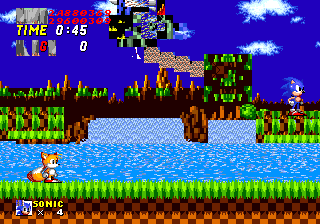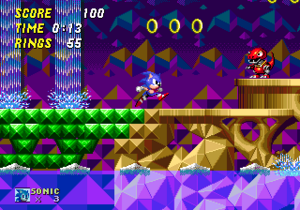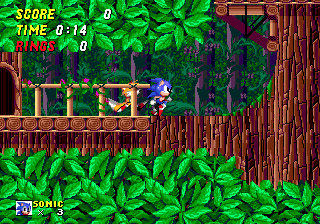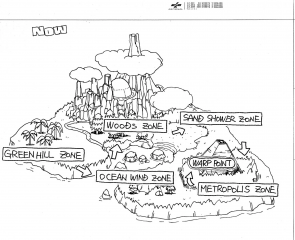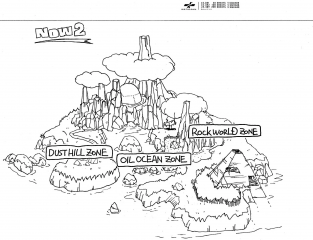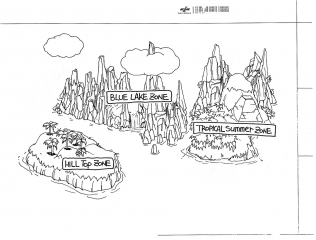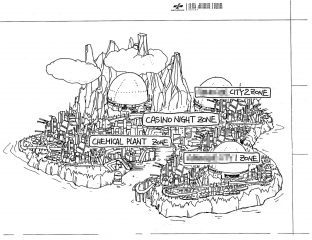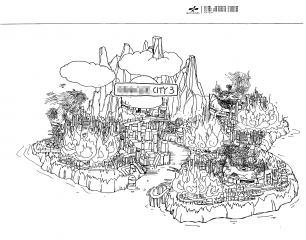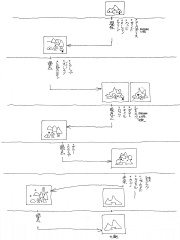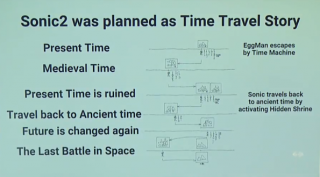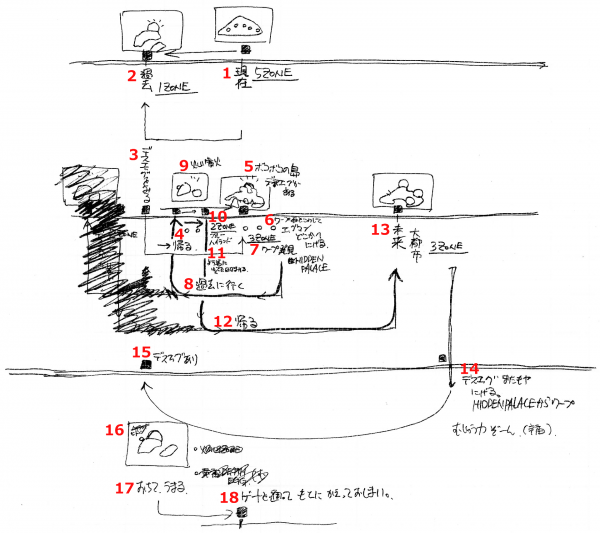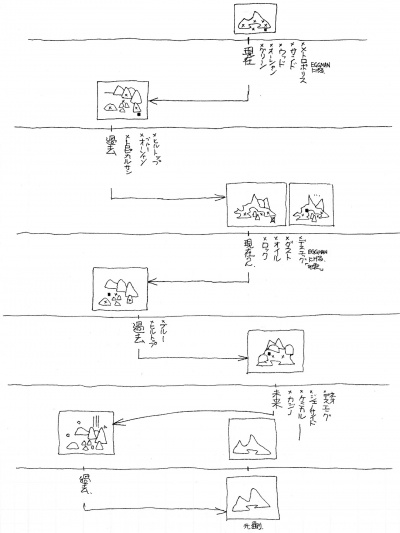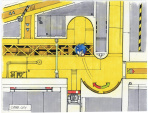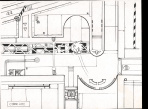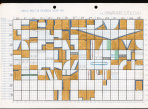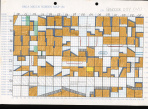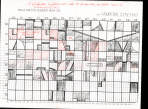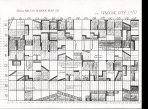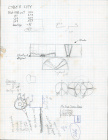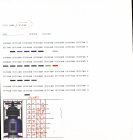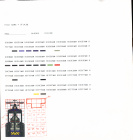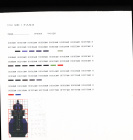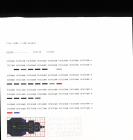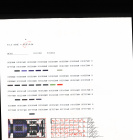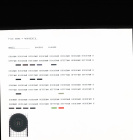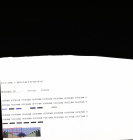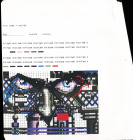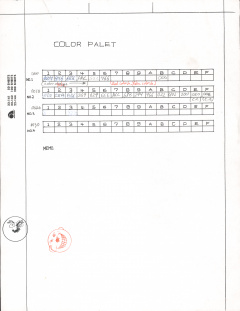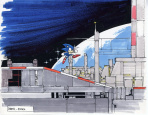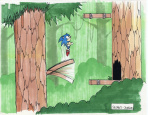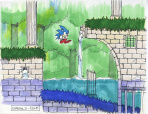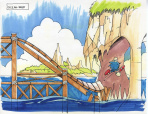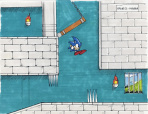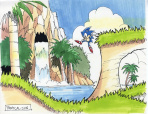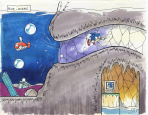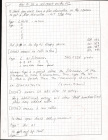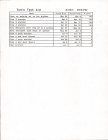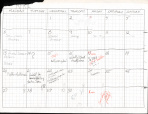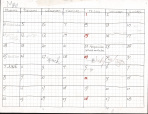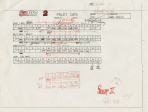Sonic the Hedgehog 2 (16-bit)/Development
From Sonic Retro
(Redirected from Game Development:Sonic the Hedgehog 2 (16-bit))
- Back to: Sonic the Hedgehog 2 (16-bit).
Contents
After the tremendous success of Sonic the Hedgehog, it was only natural to expect a sequel to the game. Though many would have assumed the original team would be already scheduled to spearhead the second entry in the series, right off the bat, problems arose that would turn the production of Sonic the Hedgehog 2 into the words legends are made of. Yuji Naka, the man responsible for the engine of the first game, had run into issues with the management of Sega of Japan. Though the game had been a success, the powers that be at the company were not happy with how everything turned out, among the disagreements the amount of time that had been spent programming the project. Growing weary of politics, Naka quit Sega, intending to look for work elsewhere.
Back in the United States, Mark Cerny, the man who had come up with the gaming classic Marble Madness, had been hired by Sega to create a new gaming studio for the company, the Sega Technical Institute (STI). The general idea behind the studio was to hire talented individuals who were only getting their start in the industry and teach them the ways of the gaming development world, not only with the talent already established in the U.S., but by talent originating from Japan who had proven themselves in a far different commercial environment. Placing advertisements in local newspapers (reading "WANTED: Video game designers and artists, no experience necessary"[1]), the resumes began pouring in, with such people as Tom Payne, Brenda Ross, and future-creator of Spyro the Dragon Craig Stitt becoming employees of this new experiment in game development.
During the production of the original Sonic the Hedgehog, Mark Cerny had already secured Hirokazu Yasuhara, the director of that project, to come out to the United States and work for STI once his job back at Sega of Japan was done. However, when Cerny learned of Yuji Naka's departure from the company, he immediately called up his long-time friend, attempting to persuade him to come out to America as well, and become a part of his venture. With the promise of a better salary and more executive power, Naka took Mark up on the offer, hiring back into the Sega fold.[2]
Though the American staff of STI cut their teeth on the game Kid Chameleon, with the arrival of Naka, Yasuhara, and a handful of other Japanese staff members, Cerny was sure Sega would give the team their biggest and most obvious assignment - the sequel to Sonic the Hedgehog. With two of the three main people behind the success of the first game (the third, Naoto Ohshima, stayed behind and eventually directed Sonic CD) it only made sense to devote the entire studio to Sega's biggest franchise, especially since Sonic had since exploded in popularity in North America.[1] Even though the Japanese staff arrived in September, it would be two months until work on the sequel began.
| “ | I'd managed to reunite two of the three key Sonic Team members...at my Sega Technical Institute. They were ready to start work on their next project, and so I asked marketing the obvious question, "would you like another Sonic?" Bizarrely, the response was, and again I kid you not, "no, it's much too soon." So we found another game to make, and in November, as we were getting started, marketing came back and said "oops, we do need that game, and we need it now." So the team lost two months out of an eleven month schedule! | „ |
| — Mark Cerny, programmer for Sonic the Hedgehog 2[3] | ||
Filled to brim with ideas, one of the first elements the team decided on was that they wanted a new main character to be introduced in the game. Before Yuji Naka agreed to become a part of the Sonic 2 team, one of his requests was that there would be a two-player mode, a feature he wanted to include in the original title, but did not have the time to implement. An internal competition was held within Sonic Team and STI to find the best character that could be used for this new addition to the franchise, and though many entries were submitted (including one from artist Craig Stitt for a flying turtle named "Boomer"), it was Yasushi Yamaguchi who won with his two-tailed fox character. Originally wanting him to be named "Miles Prower"[1], the rest of the team felt his name should simply be "Tails," to match the simplistic nature of Sonic's name. Unhappy with this idea, Yamaguchi (who became the lead zone artist in the game) decided to sneak the name "Miles Prower" into various concept art and in the game, making both names legitimate in the end.
Being nothing less than ambitious, the original plan was to make a sprawling, 18-zone epic, revisiting the unique level tropes Sonic Team had created for the first game, putting their own spin on traditional platformer levels like desert and snow worlds, and even come up with some ideas that would be totally new. Emerald Hill, Hill Top, Oil Ocean, Hidden Palace, Sand Shower and a winter-themed level were some of the first levels to be worked on, the concept of time travel also being talked about in early production meetings. However, it became obvious early on that if they were to have the game ready for the Christmas season of 1992, they could not finish every world that was on the drawing board. The time travel concept was dropped almost immediately, and Sand Shower and its winter counterpart were some of the first zones to be put on the chopping block, much to the chagrin of Brenda Ross, the artist responsible for their appearance.[4] Craig Stitt, the primary artist assigned to Oil Ocean[5], recalls the zone's design was inspired by San Francisco's Golden Gate Bridge[1] and the large natural gas storage tanks near its base.[6]
Though the two sides of STI tried to work together, the language barrier proved to be too much at times. Most of the meetings for the direction of Sonic the Hedgehog 2 were done in Japanese (Mark Cerny being fluent in the language[1]), leaving the American side in the dust. Trying to mesh the two cultures and work ethics became a challenge in itself, with some members unable to get along with Yuji Naka's intense personality. Tom Payne, who himself never had any issues with the Japanese half of the team, recalled in an interview later the stark differences between the American mindset of a nine-to-five job and the Japanese mindset of working almost all hours of the night, with members like Yamaguchi and Yasuhara being extremely passionate with the quality of the whole:
Even knowing early on they would not have enough time to work on everything they had set out to in the beginning, as the release date drew nearer, it became more than obvious that the team would have barely enough time to finish the eleven zones that ended up in the final game. Genocide City Zone, a three-act level that was meant to be towards the end of the game (and was also called "Cyber City", an alternate name in consideration due to the Japanese staff not fully realizing what "genocide" meant), was scrapped. The very last level to be removed was one of the first that had been worked on, the Hidden Palace Zone. Conceived as an area Sonic would warp to after collecting all seven Chaos Emeralds, both game flow and deadlines forced the team to drop it, instead awarding the power of Super Sonic immediately after the seventh special stage was completed.

To make the deadline, Sega of Japan, only a few weeks before the Christmas selling season, had thirteen additional Japanese staff members fly out to San Francisco to iron out any issues or problems the game had[2]. Details, such as the title screen, were changed days before it was to be certified, and even the game credits were thrown together at the last minute, causing some people to be miscredited in terms of what they contributed to Sonic 2.
The game was released simultaneously in the United States and Europe on "Sonic 2sday." A marketing campaign promoting the concept of "blast processing" was pursued, while back in Japan the campaign focused on the introduction of "Tails." The entire team, both American and Japanese, celebrated together on November 23rd, 1992, proud of the game that, against the odds, would not only be the biggest selling Sonic game on the Mega Drive, but the best selling game of the 16-bit era.
Also of note is the fact the game contained references to some of the biggest pop culture phenomenons on both sides of the Pacific. The Death Egg, Eggman's ultimate weapon in the game, was modeled after the Death Star, the superweapon featured in the Star Wars trilogy. Meanwhile, the introduction of Super Sonic was an homage to the well-known Chinese fable The Golden Warrior and its then-current interpretation being published in Japan, Dragon Ball.
It is also possible that a Mega-CD port of Sonic the Hedgehog 2 was planned early on in the development cycle, but it was decided that the team should remain focused on the Mega Drive cart.
Artwork
With the lead artist of the first Sonic the Hedgehog, Naoto Ohshima, residing in Japan, the role for Sonic 2 was assigned to Yasushi Yamaguchi ("Judy Toyoda"), another Japanese artist flown in to STI. As well as creating both Tails and Mecha Sonic, Yamaguchi oversaw all of the artwork in the game[7] and kept a "watchful eye" on the three American "Zone artists"; Tom Payne, Craig Stitt and Brenda Ross[7]. Yamaguchi himself was overseen by Yuji Naka who would also demand corrections for art seen as not up to standard[2], and Mark Cerny also had input[1].
For these three developers, Yamaguchi would typically draw up some concept art for a Zone and a (non-final) name, Hirokazu Yasuhara would supply a layout[7][1], and the Americans, alongside Jina Ishiwatari and Rieko Kodama who worked on the first game, were tasked with producing level graphics[7][2]. Simple lists of 128x128 level "chunks" would be compiled, and the artists would attempt to turn them into game worthy pixel-art.
Other than these basic concepts, the artists only Sonic 1 graphics for inspiration[7], as the music was created separately.

Zones were spread across the artists: Tom Payne was tasked with Metropolis Zone and Genocide City Zone, Craig Stitt handled Oil Ocean Zone and Hidden Palace Zone[5], and Brenda Ross tackled the "Desert" and "Winter" Zones, alongside Wood Zone. Other than Rieko Kodama handling the original art of Casino Night Zone (which was radically re-drawn by Yamaguchi, owing to Kodama's lack of knowledge of casinos[8]) the ownership of the remaining Zones is not known, though Yamaguchi likely had a hand in creating all of them.
The Special Stage art was handled by Tim Skelly, save for the characters and objects which were drawn by Yamaguchi[2]. Peter Morawiec is credited but according to Skelly was not actually involved[2]. Skelly also worked on "3D" objects that required computer rendering, such as the corkscrews in Emerald Hill and the nets in Metropolis Zone[2].
With so many Zones planned, it was decided to recycle artwork where possible to reduce the workload, with levels spaced apart so the repetition would be less obvious[2]. The most notable of these is Hill Top Zone using art from Emerald Hill Zone (Death Egg Zone also recycling art from Chemical Plant Zone), but there were similar plans at points for Metropolis and Genocide City to share artwork, and the Desert and Winter Zones[9][2].
There was some dismay among the American artists[1], as many of their Zones were cut from the final game. None of Brenda Ross (the last artist to join[9])'s contributions made it into the final product, fueling the idea that the Japanese output was favoured over work from the Americans. In the case of Genocide City and Hidden Palace, some art was reused in subsequent STI projects such as Sonic Spinball.
Tom Payne was also tasked with producing many of the enemies in the game, creating early versions of Buzzer, Crawl and Masher. Many more, such as Gator, Stegway and various iterations of Snail, are assumed to have fallen short of quality expectations and so were not included in the final product.
As was the standard in Japan at the time, all pixel art was created using Digitizer System III machines. STI's normal workflow appears to have been to use Amiga computers with Deluxe Paint (and indeed continued to be used after Sonic 2 for STI projects).
Music
Just like the first game, Masato Nakamura, leader of the band Dreams Come True, was in charge of creating the soundtrack to Sonic 2. Wanting to stay faithful to what he had done in the first game, but give the audience even more, Nakamura felt the pressure of writing music that would satisfy fans of the first[10]. With the game released and receiving all sorts of praise, Nakamura decided to give something back to the team that had given him the chance to create the music in the first place.
| “ | [A]fter finishing all of the tracks for the sequel, Nakamura sent me a fax saying, "I've got a present for you. It's a surprise!" The other members of Sonic Team and I tried to figure out what it might be, but we could never have guessed that Nakamura reworked the ending theme that he provided for us for Sonic the Hedgehog 2 into a song entitled "SWEET SWEET SWEET" for inclusion on the DREAMS COME TRUE album that he worked on in London. I remember how ecstatic and moved all of us on Sonic Team were upon learning of our "present." That particular song remains a huge favorite of mine, and continues to hold very strong memories for me. For that, I am truly grateful. | „ |
| — Yuji Naka, Chief Programmer for Sonic the Hedgehog 2[11] | ||
Late into the game's development, Sega of America audio director David Javelosa composed a track in a perceived Sonic-like style, titled "Night Club Scene".[12] Produced on the musician's own time late into the project's development and preserved on his DJ Demo Reel cartridge, it was once speculated to be an unused track from the game's development - particularly as it was composed with a "Sonic 2" sound module. However, in December 2023, Javelosa confirmed this was not the case, revealing that "Night Club Zone" was composed to familiarize himself with the company's GEMS sound driver.[13]
Super Sonic
Super Sonic was created in response to manga artist Sakura Tamakichi's Shiawase no Katachi column in Famicom Tsuushin. Tamakichi desperately played the original Sonic the Hedgehog to see the true ending, only to be disappointed by the result. Because of this, the Sonic 2 development team decided that there should be a proper reward for collecting all of the Chaos Emeralds.[14] The idea for Sonic to have both the super speed and invincibility power-ups, with a time limit based on the consumption of rings, was decided relatively quickly. The graphics proved to be a bigger problem, as it would have been impossible to redraw all of Sonic's sprites while keeping within the game's deadline and the memory capacity of the cartridge, so it was decided to make do with color changes and effects. Various effects were tried, such as a seven color glowing figure, but none of them were good enough. In desperation, Yasushi Yamaguchi drew unique sprites for Super Sonic's basic and running animations, as well as a transformation animation, while the rest of the sprites only received color changes.
Yamaguchi began work on Super Sonic's ending picture at 1:00am of the game's "master up" ("going gold") day. The deadline was so tight that if they had an hour less then the good ending image would have remained as the regular Sonic.
Super Sonic's design was inspired by the popular manga and anime series Dragon Ball: in a 1991 storyline the protagonist Son Goku achieved a powerful new "Super Saiyan" form, which made his hair stand on end turn golden blond.
The number of Chaos Emeralds was increased to seven, from the original game's six, as it was felt that it would have been strange if collecting 6 Chaos Emeralds did nothing in the first game, but collecting the same number in the second game granted a power-up. So it was decided that there was actually a seventh "hidden" emerald. Although Dragon Ball inspired the look of Super Sonic, the number of Chaos Emeralds wasn't inspired by the series' seven eponymous Dragon Balls, and is purely coincidental.[15]
Prototypes
As with most games of the era, several unfinished prototypes of Sonic 2 were built for demonstration purposes, be it at trade events or for magazine preview coverage, over the summer of 1992. Sonic 2 is unique in that most publicly previewed prototypes have been leaked onto the internet, allowing us to chart the game's development from little more than a reskin of Sonic 1, to its final iteration.
The earliest prototype known to exist is colloquially known as the "Nick Arcade prototype", as it was first spotted on the children's US television game show Nick Arcade, shown on the Nickelodeon network. More likely, however, is that this build was created for Summer CES 1992, where it was shown behind closed doors to journalists. This incredibly early build was leaked onto the internet in 2006 and still bears a heavy resemblance to Sonic 1, complete with music and a partially-working Green Hill Zone stage.
A demo made playable for the public was shown at a New York toy show, however poor security meant the cartridge was stolen[16], with the prototype circulating online bulletin board systems during the 1990s. It later came to be known as the "Simon Wai" prototype (named after the man who discovered the ROM image in 1999, and subsequently began showcasing its differences). This is one of the most famous prototypes in the history of video games, not only being the first Sonic 2 build to be found, but showcasing several scrapped Zones and ideas, including Wood Zone and the infamous Hidden Palace Zone. This initial coverage formed the foundation of the Sonic Retro wiki.
Following the Simon Wai build, "alpha" and "pre-beta" versions of the game were demonstrated in August and September 1992. The hacking group CENSOR managed to find and release a build, passing it off as the full game for a brief period before the finished product came to market. There are also five internal testing builds, starting with "beta 4" that were leaked in 2008.
With ten prototype versions of Sonic 2 in total, covering the final four months of development, we can see changes in the game's core structure; the additions of Sky Chase Zone and Wing Fortress Zone to replace concepts such as Genocide City Zone, as well as unused enemy and object ideas, the evolution of Sonic's new Spin Dash ability and the role of Tails.
Concept art
Time travel
In May 2017, Sonic 2's "planner", Hirokazu Yasuhara detailed some of the earlier stages of Sonic the Hedgehog 2's development as part of a game design presentation at Digital Dragons 2017[17]. Of particular note is the idea that Sonic 2 once incorporated a time travelling mechanic - a feature that was never mentioned in public at the time, but coincidentally found itself in a different guise as part of Sonic the Hedgehog CD.
However, Sonic 2's version of time travel was something very different - time zones would be accessed in a more linear way, and rather than appear as re-skinned and slightly tweaked versions of the same levels, each time period would have an entirely new set of stages.
Yasuhara's presentation featured multiple slides detailing a scrapped world map feature, and a rough idea of how the time periods linked together:
A document illustrates the overall events of the game:
Another document details an early list of stages:
Present
- Green - Green Hill Zone, expected to have become Emerald Hill Zone
- Ocean - Ocean Wind Zone, Concept art of the same name
- Wood - Wood Zone, a scrapped stage
- Sand - Sand Shower Zone, a potential desert-themed level
- Metropolis - Metropolis Zone
"Eggman escapes."
Past
- Tropical Sun - Concept art of the same name; Known as "Tropical Plant Zone" in the map concept art
- Blue Ocean - Concept art of the same name; Known as "Blue Lake Zone" in the map concept art
- Hill Top - Hill Top Zone
Present 2
- Rock - Rock World Zone, a scrapped stage
- Oil - Oil Ocean Zone
- Dust - Dust Hill Zone, expected to have become Mystic Cave Zone
- Death Egg - Death Egg Zone
"Eggman escapes. 'Earthquake'"
Past
- Hill Top - Hill Top Zone
- Blue - Likely Blue Ocean/Blue Lake Zone
Future
- Casino - Casino Night Zone
- Chemical - Chemical Plant Zone
- Genocide - Genocide City Zone, a scrapped stage
- Neo Death Egg
Past
The diagram appears to use action lines to represent the Death Egg crashing down.
Yasuhara's plans here are very early, likely debuting before any meaningful development work had begun on the game. The concept is believed to have been dropped prior to the game's public announcement, but these initial plans still shaped the final product. For example, Hill Top Zone contains volcanoes and lava, congruent with a volcanic eruption event in the early plot, and graphics are shared with Emerald Hill Zone (originally Green Hill Zone), its present counterpart.
Character art
Initial line art of Sonic and Tails used on the Japanese boxart. Scan from Sonic Generations.
Dr. Eggman and his many facial expressions. Scan from Sonic Jam.
Concept art of Eggman's Mobile. Scan from Sonic Jam.
Enemies
| |
Main article: Sonic the Hedgehog 2 (16-bit) scrapped enemies |
Levels
Metropolis Zone
| |
Main article: Sonic the Hedgehog 2 (16-bit)/Development/Metropolis Zone |
Genocide City Zone/Cyber City Zone
Palette
Assorted levels
Concept art for Secret Jungle, which resembles the scrapped Wood Zone.
Concept art for Emerald Isle, which resembles Aquatic Ruin Zone.
Sonic and Tails near a large ramp. Most likely Emerald Hill Zone.
The familiar "moving blocks" area from Chemical Plant Zone.
Various ideas for Sky Chase Zone, and possibly Hill Top Zone.
Sky Chase Zone, and possibly Wing Fortress Zone.
Miscellaneous documents
Tom Payne
These are documents recovered from artist Tom Payne.
Collision array
Early cartridge labels
On July 1st 2014, Al Nilsen posted on his Twitter account, early holographic labels for Sonic 2. They were not used on the final game due to the amount of money it cost to produce the labels, but one label was used for the Nick Arcade prototype of Sonic 2.
Promotional Screenshots
Early Mock-Ups
In the early months of 1992, Sega released a small handful of Sonic 2 "screenshots" alongside confirmation of the game's existence. However, under closer inspection you can see that these are not screenshots at all, but instead mockups using what few assets were currently available at the time (and sprites from Sonic 1). In all these mockups, Sonic is off-centre, the layout does not exist in the final game, and enemy and ring placements are strange.
According to Craig Stitt, who produced the Hidden Palace mockup, these were created by the Zone artists because they were not yet running in the game itself[1].
An early mockup of Emerald Hill Zone with an off-center Sonic. Note the Green Hill Zone clouds in the background and the Sonic 1 HUD.
An early mockup screenshot of Hidden Palace Zone. Sonic is off center and there is a background not seen in any later screenshots.
A conceptual mockup of a desert zone. "Gator" exists within early prototypes of the game.
Summer 1992 Screenshots
Over the summer, possibly for Summer CES 1992, Sega released a handful of "real" Sonic 2 screenshots. They appear to be consistent with the "Simon Wai" prototype, with different graphics and Tails showing signs of his older AI scripts. However saying that, it is fully possible he was being controlled by the second player, in order to get the best possible screenshot composition.
This marks the first time Sonic 2 was shown to the general public at large - the "Nick Arcade" prototype was likely shown to journalists behind the scenes at Summer CES 1992 (and of course appeared on Nick Arcade, as well as being teased in Sega Visions), but cruicially, this is the first time Tails was seen on-screen.
In North America, Sonic 2's box art uses three of these screenshots, rather than images from the final game.
See also
- Sonic Panic - A ten minute look into the creation and development of Sonic the Hedgehog 2, featuring Yuji Naka and some guests. Was given away in Japan to those who had preordered the game.
- Sonic Retro discussion thread (April 2023)
References
- ↑ 1.0 1.1 1.2 1.3 1.4 1.5 1.6 1.7 1.8 Interview: Craig Stitt (2001-01-23) by ICEknight
- ↑ 2.0 2.1 2.2 2.3 2.4 2.5 2.6 2.7 2.8 Tim Skelly interview by ICEknight (August 2004)
- ↑ Mark Cerny interview by Sega-16 (December 5, 2006)
- ↑ Brenda Ross interview by Deviance (February 2001)
- ↑ 5.0 5.1 File:CraigStitt videoresume 1995.mp4
- ↑ https://www.youtube.com/watch?v=UOlHbBTF8eI
- ↑ 7.0 7.1 7.2 7.3 7.4 Tom Payne interview by SageXPO (July 30, 2009)
- ↑ @judy_totoya on Twitter (Wayback Machine: 2022-11-29 22:41)
- ↑ 9.0 9.1 Brenda Ross interview by Deviance (February 2001)
- ↑ File:Sonic1&2Soundtrack JP Booklet.pdf, page 9
- ↑ File:Sonic1&2Soundtrack JP Booklet.pdf, page 7
- ↑ https://www.youtube.com/watch?v=rJLkkOxRP8Y (Ghostarchive)
- ↑ Interview: David Javelosa (2023-12-09) by Alexander Rojas
- ↑ @judy_totoya on Twitter (Ghostarchive)
- ↑ @judy_totoya on Twitter (Ghostarchive)
- ↑ Interview: Yuji Naka (2005-09-30) by GameSpy
- ↑ @necrosofty on Twitter (Ghostarchive)
| Sonic the Hedgehog 2 (16-bit) | |
|---|---|
|
Main page (KiS2|2013|3D|Ages) Manuals Development |
show;hide
Scrapped Levels: Scrapped Enemies: 2013 remake only: 2013 remake only: Knuckles in Sonic 2 Prototypes: |

